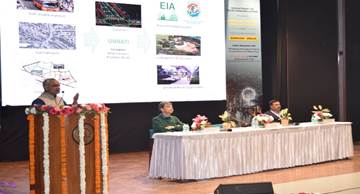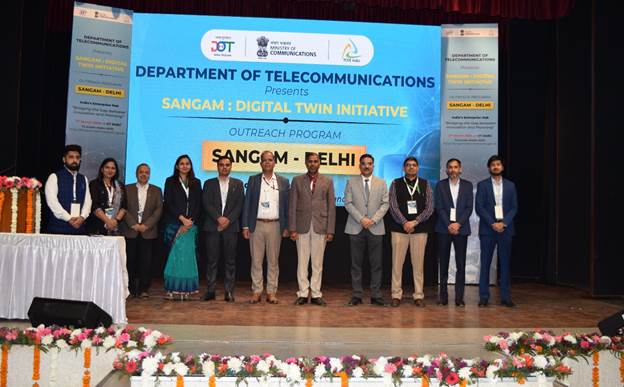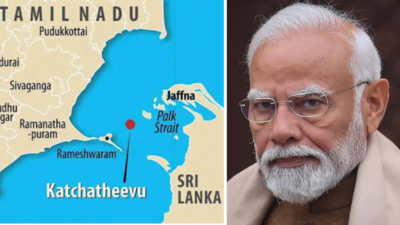The Department of Telecommunications (DoT), through its Telecom Center of Excellence (TCOE), has embarked on a groundbreaking initiative called “Sangam: Digital Twin,” aiming to revolutionize infrastructure planning and management through the transformative power of digital twin technology. This initiative signifies a paradigm shift in how we approach infrastructure development, fostering a collaborative ecosystem that leverages cutting-edge technology, data-driven insights, and collective expertise.
 The inaugural outreach program for Sangam, held at the prestigious Indian Institute of Technology Delhi (IIT Delhi), served as a springboard for engaging a diverse range of stakeholders in the initiative. Under the theme “Bridging the gap between Innovation and Planning,” the event brought together industry leaders, startups, academia, and innovators to explore the potential of digital twins in shaping the future of urban development. This collaborative approach underscores the importance of collective thinking and knowledge sharing in driving innovation and ensuring the successful implementation of the Sangam initiative.
The inaugural outreach program for Sangam, held at the prestigious Indian Institute of Technology Delhi (IIT Delhi), served as a springboard for engaging a diverse range of stakeholders in the initiative. Under the theme “Bridging the gap between Innovation and Planning,” the event brought together industry leaders, startups, academia, and innovators to explore the potential of digital twins in shaping the future of urban development. This collaborative approach underscores the importance of collective thinking and knowledge sharing in driving innovation and ensuring the successful implementation of the Sangam initiative.
Dr. Neeraj Mittal, Secretary of Telecom, delivered a thought-provoking keynote address, emphasizing the transformative potential of digital twins in several key areas:
-
Modernization and Optimization: Digital twins enable the creation of virtual replicas of physical assets, allowing for proactive maintenance, predictive analysis, and optimized resource allocation. This extends the lifespan and improves the efficiency of existing infrastructure, leading to cost savings, improved service delivery, and reduced downtime.
-
Innovation and Experimentation: Digital twins provide a platform for simulating and testing various scenarios before real-world implementation. This experimentation fosters innovation and facilitates the exploration of novel approaches to infrastructure development, potentially leading to the creation of more sustainable, efficient, and resilient infrastructure systems.
-
Data-Driven Decision-Making: By creating a shared information platform, digital twins facilitate data-driven decision-making, ensuring that decisions are based on real-time insights and comprehensive data analysis. This approach leads to more informed and strategic investments, reducing the risk of costly mistakes and optimizing resource utilization.
-
Sustainable Infrastructure Development: Digital twins can contribute significantly to achieving sustainable infrastructure development goals. By enabling data-driven insights and predictive modelling, digital twins can optimize resource utilization, minimize environmental impact, and ensure the long-term sustainability of infrastructure projects. This focus on sustainability is crucial in addressing the challenges of climate change and ensuring a healthy planet for future generations.
Dr Mittal also highlighted the importance of leveraging digital twins and integrated data systems to optimize infrastructure planning and ensure long-term sustainability.
The outreach program delved into various themes, each focusing on a specific aspect of digital twin technology and its potential applications in infrastructure development:
Industry leaders showcased cutting-edge solutions in smart infrastructure, geospatial mastery, and Building Information Modeling (BIM). These technologies, when integrated with digital twins, create a comprehensive and dynamic view of physical assets, providing valuable insights into their real-time status, operational efficiency, and potential challenges. This comprehensive understanding empowers stakeholders to make informed decisions regarding maintenance, upgrades, resource allocation, and potential future developments.
Experts discussed strategies for integrating data streams from diverse sources, including road traffic insights, telecom insights, environmental data, and sensor data from various aspects of the infrastructure itself. This comprehensive data collection and analysis are essential for creating a truly dynamic and informative digital twin. The ability to integrate and analyze data from various sources allows for a holistic understanding of the infrastructure ecosystem, enabling stakeholders to make informed decisions based on real-time information, anticipate potential issues before they arise, and optimize performance across the entire system.
Participants explored how advanced technologies like Artificial Intelligence (AI), Machine Learning (ML), and Privacy Enhancing Technologies (PETs) can be leveraged in conjunction with digital twins. AI and ML can be used to analyze data and create predictive models, enabling proactive maintenance, optimized resource allocation, and the identification of potential issues before they escalate into major problems. Pets, on the other hand, ensure data privacy and security throughout the process, addressing concerns and fostering trust among stakeholders. This responsible use of technology ensures that the benefits of digital twins are realized while safeguarding individual privacy and fostering trust-based collaboration.




